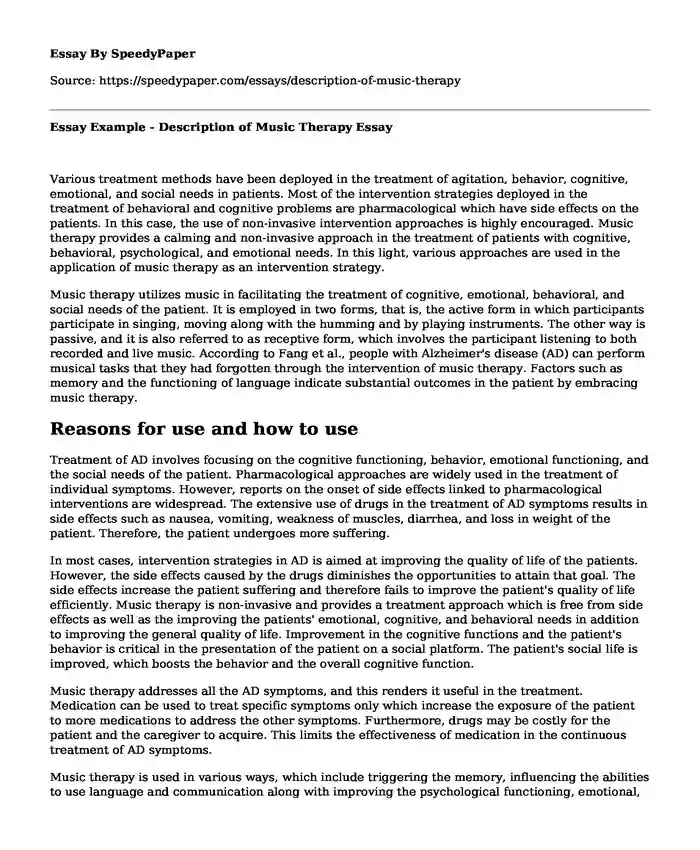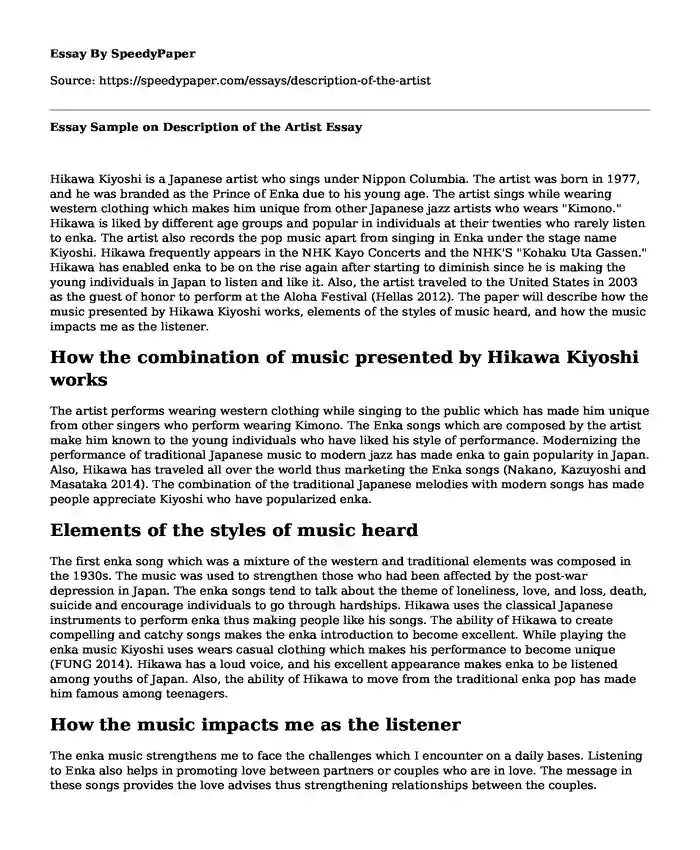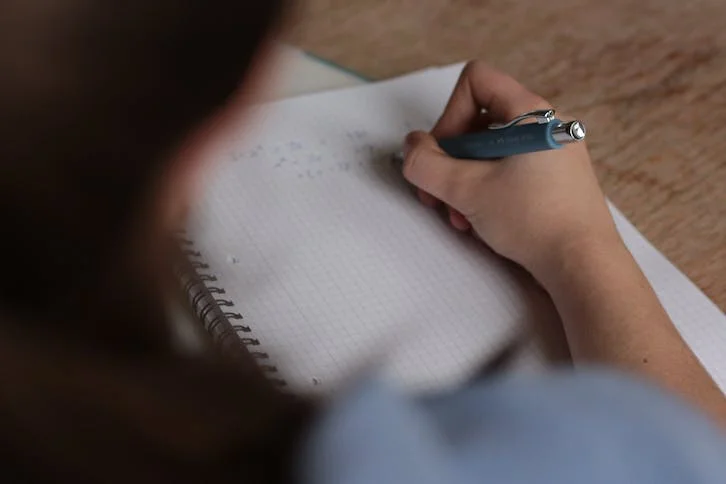
How to write a descriptive paper: useful guide with topics & samples
As a student, you must often write descriptive essays as part of your coursework. Whether you are describing a person, place, or thing, a descriptive essay should transport the reader to the subject and create a vivid picture. In this guide, we will explore a descriptive essay's purpose and provide useful tips and examples to help you write a compelling paper. Surely you want to know how to write a descriptive essay. Here is a guide that will help you!
What is a descriptive essay?
Let's start with the solid descriptive essay definition. Such an essay is an academic writing that uses sensory details to create a picture of a person, place, or thing in the reader's mind. Unlike other essays that rely on argument and persuasion, a descriptive essay focuses on the description and is meant to transport the reader to the subject.
What is the purpose of a descriptive essay
The purpose of a descriptive essay is to create a sensory experience for the reader. Using descriptive language and appealing to the senses, the writer can make the reader feel like they are experiencing the subject firsthand. Descriptive essays can evoke emotions, capture memories, or simply paint a picture for the reader.
How to write a descriptive essay
Writing a descriptive essay requires careful attention to detail and the use of sensory language to paint a vivid picture in the reader's mind. And it can be an enjoyable and creative experience if done correctly. In this guide, we (Speedy Paper) will provide a clear and concise way to write a descriptive essay to captivate your readers. Before you start writing, take time to conduct a brainstorm to determine what you want to describe in your work – it could be a person, object, emotion, or even a memory. To earn a high grade in the English class, you need to write a descriptive essay that effectively captures the essence of the subject you are describing.
Good descriptive essay topic ideas
When writing a descriptive essay, it is important to choose a topic that allows you to create a rich and engaging sensory experience for your reader. Surely you will be more interested in writing about something associated with positive emotions. So here are 20 descriptive essay topics to inspire your creativity:
- A childhood memory.
- The view from your bedroom window.
- Your favorite place to relax.
- The first day of school.
- A family member.
- A piece of art or sculpture.
- Your favorite restaurant.
- A city or town that you love.
- The interior of your dream house.
- Your favorite animal.
- A special day in your life.
- The beach at sunset.
- A historical site or monument.
- A character from a book or movie.
- A sports event or game.
- A song that means something to you.
- My descriptive narrative idea.
- Using SLP descriptive statistics.
- Descriptive statistics in criminal justice.
- My honest descriptive experience.
Remember, the key to a successful descriptive essay is to select a topic you feel passionate about and use vivid and sensory language to create a clear and engaging picture in the reader's mind. As you can see, good descriptive essay ideas will help you cut down on data analysis before starting writing activities.
Detailed data collection
Many beginners don't know how to start a descriptive essay. However, there is nothing difficult in starting a writing activity. After selecting your topic, it's important to collect detailed data to gather all the necessary information for your descriptive essay. It includes names, dates, physical characteristics, background, emotions, and other relevant details that will help you paint a vivid picture for your readers.
Tip from SpeedyPaper:Use all five senses to gather information. It means paying attention to not only what you see but also what you hear, smell, taste, and feel.
Using all five senses, you can create a more vivid and engaging description that will transport your reader to the scene you are describing.
Craft your descriptive essay outline
Once you have collected all the necessary data, it's time to craft your descriptive essay outline. It will help you organize your thoughts and ensure your essay flows smoothly. Here's an outline for a descriptive essay you can use to stand out.
Introduction
- Hook your readers with an interesting opening sentence
- Provide some background information on your topic
- Introduce your thesis statement
Body paragraph 1
- Start with a topic sentence that sets the scene for your readers
- Describe the physical appearance of your subject
- Use sensory details to bring your subject to life
Body paragraph 2
- Start with a transition sentence that connects to the previous paragraph
- Describe the emotions that your subject evokes
- Use anecdotes or personal experiences to add depth to your description
Body paragraph 3
- Start with a transition sentence that connects to the previous paragraph
- Describe the sounds or smells associated with your subject
- Use figurative language to create vivid imagery
Conclusion
- Summarize the main points of your essay
- Restate your thesis statement in a new way
- Leave your readers with a final thought or question to ponder
Remember, the key to a successful essay is to use descriptive language and appeal to the senses while staying focused on your topic. Use the right format of a descriptive essay! With a solid outline, your writing will flow smoothly, and your readers will be captivated by your vivid descriptions.
Tip from SpeedyPaper:Be flexible with your paper structure. Your outline should provide a general guide for your writing, but it should also allow for flexibility and spontaneity as you develop your ideas.
Additionally, breaking your essay into smaller, more manageable sections can make the writing process less daunting and help you focus on your main points.
Solid descriptive essay introduction
A good introduction to the descriptive essay should grab the reader's attention with a compelling opening sentence or hook and provide background information on the topic. But don't forget to add a thesis statement for descriptive essay papers at the end of your intro as it previews the essay's main points. The introduction should set the tone for the rest of the essay and give the reader a clear idea of what to expect. However, you should look at how to craft this paper part. Here are examples of good and bad introductory paragraphs for a descriptive essay:
Good:Bad:As I step into my grandmother's kitchen, the sweet aroma of freshly baked chocolate chip cookies wafts through the air. The familiar sight of her flour-dusted apron and her gentle humming immediately transports me back to my childhood, when I spent countless afternoons watching her whip up delicious treats in this very spot.
In this essay, I will describe my grandmother's kitchen. It's a place I love and visit often.
Crafting the body part
Now let's look at how to write a descriptive essay and focus on the body paragraphs. Those paragraphs should focus on a specific aspect of the subject being described. Start each paragraph with a topic sentence that sets the scene and describes what the reader can expect to learn in that section. Use sensory details, vivid language, and specific examples to bring your subject to life and paint a clear picture in the reader's mind. Add each transition smoothly between paragraphs by using connecting words and phrases that signal a shift in focus. Here are a few examples of good and bad body paragraphs for a descriptive essay:
Good:Bad:The walls of my grandmother's kitchen are lined with dozens of colorful ceramic plates, each bearing a different pattern or design. The warm afternoon light filters through the lace curtains, casting a soft glow over the room. As my grandmother mixes the dough for her famous chocolate chip cookies, I sit at the wooden table and breathe in the comforting scents of vanilla and sugar. I feel safe and content here, surrounded by the familiar sights and sounds of home.
My grandmother's kitchen is nice. There are plates on the walls and curtains on the windows. She makes cookies that smell good.
Perfect descriptive essay conclusion
The concluding paragraph of a descriptive essay should summarize the main points of the essay clearly and concisely. Restate the thesis statement differently, using slightly different language to avoid repetition. Leave the reader with a final thought or question that ties back to the essay's main theme. The conclusion should leave the reader with closure and a lasting impression of the described subject. Here are a few examples of good and bad concluding paragraphs for your descriptive essay:
Good:Bad:As I leave my grandmother's kitchen, I feel a sense of warmth and comfort that will stay with me long after I'm gone. This place has seen generations of family members come and go, a place that holds a special meaning for each of us. As I step out into the sunlight, I take one last deep breath of the sweet, familiar scents that permeate this space, knowing I'll always carry a piece of this magical place with me wherever I go.
Tip from SpeedyPaper:In conclusion, my grandmother's kitchen is a nice place to be.
Avoid introducing any new information! Your conclusion should summarize your main points and provide closure for your essay, but it should not introduce new information or ideas.
Additionally, ending with a memorable image or thought can help leave a lasting impression on your reader and tie your essay together satisfactorily.
Editing & proofreading process
After finishing the first draft of your descriptive essay, it's essential to take the time to review and revise your work. Re-read your essay carefully, looking for any grammar, punctuation, or spelling errors. Check that your sentences are clear and concise and your paragraphs flow smoothly from one to the next. Consider asking a friend or family member to read your essay and provide feedback, as a fresh set of eyes can often catch mistakes you might miss.
Tip from SpeedyPaper:Additionally, reading aloud can help you to identify areas of your essay that may need more sensory description or clarification.Try to read it out loud. By reading your work aloud, you will be able to hear any awkward phrasing or errors in grammar and punctuation that you may have missed while reading silently.
Why is choosing the right topic important?
Choosing the right topic when writing a descriptive essay is the first step to creating an engaging narrative. The right topic sparks your creativity and makes the process enjoyable. The subject matter paves the way for the flow of your ideas and expressions. So, if you need help writing a paper, remember that a carefully chosen topic can make a huge difference in the quality and impact of your essay.Five essay topics for inspiration
Picking the right descriptive essay topics can sometimes be tricky, especially when the choice is broad. Let's eliminate this hurdle and consider ten diverse topics that might stimulate your creativity and provide a fruitful ground for your descriptive essay. These topics offer a wide range of scopes for your narratives, and this variation might be the essay writer help you need.
- An unforgettable childhood memory.
- My first experience with snow.
- The most beautiful place I've visited.
- A character from my favorite book.
- The best meal I've ever had.
Interesting descriptive essay examples
We understand the importance of providing students with high-quality samples to help inspire their writing. We've posted a couple of interesting examples here that any student can use as a source of inspiration when crafting their descriptive essays. Check each descriptive essay sample to boost your writing process.
However, suppose you need more personalized assistance. In that case, our expert writers can create a similar paper tailored to your specific topic and requirements or even craft an essay from scratch with an original approach. Contact us to learn more about our services and how we can help you succeed academically.


Conclusion
In conclusion, writing a descriptive essay can be a fun and rewarding experience if you approach it with the right mindset and follow the steps outlined in this guide. Students can take any topics provided as examples or choose their topic to write about. By following our tips and examples, you can learn how to create a compelling and vivid descriptive essay that will engage your readers.
Additionally, if you need assistance writing an essay, our site has guides and expert writers available to help you achieve academic success. You can also learn how to write a synthesis essay and other papers. We pride ourselves on promptly providing high-quality, original work and are committed to helping students achieve their academic goals. Contact us today to learn more about our services and how we can assist you. We will select the best descriptive essay writer so you can count on polished works!




Comments (0)
Thank you for your comment! 🌟
It has been submitted and is awaiting moderation. Stay tuned—it will be visible soon!